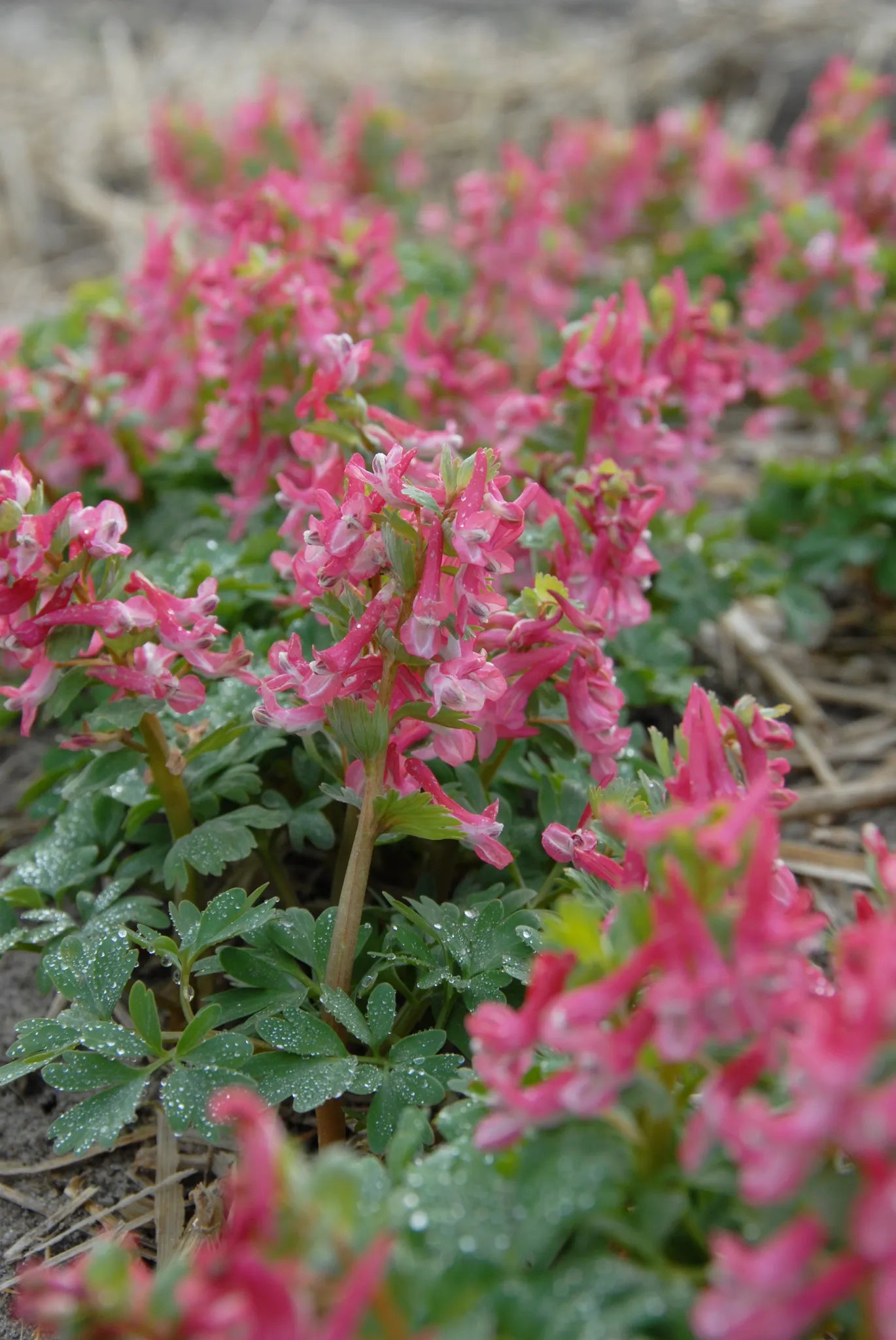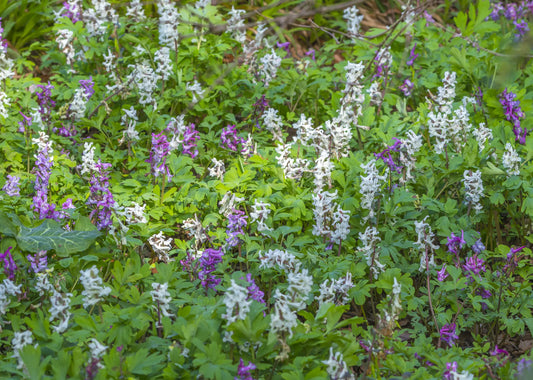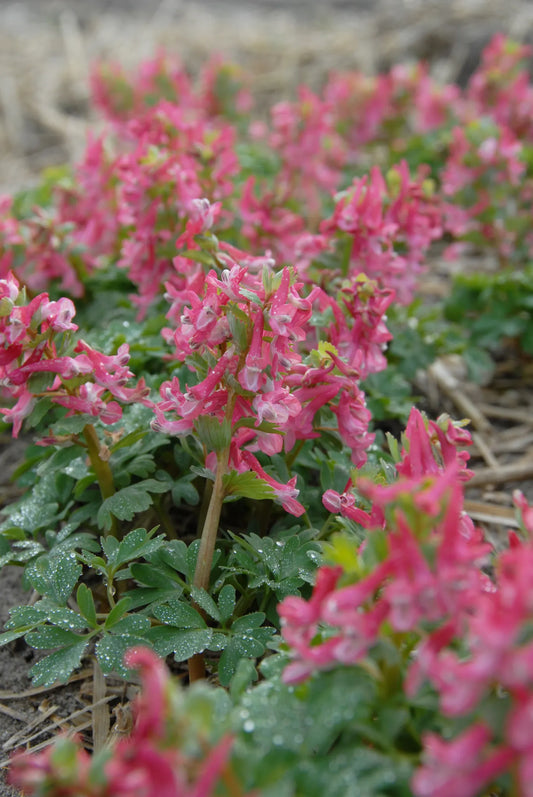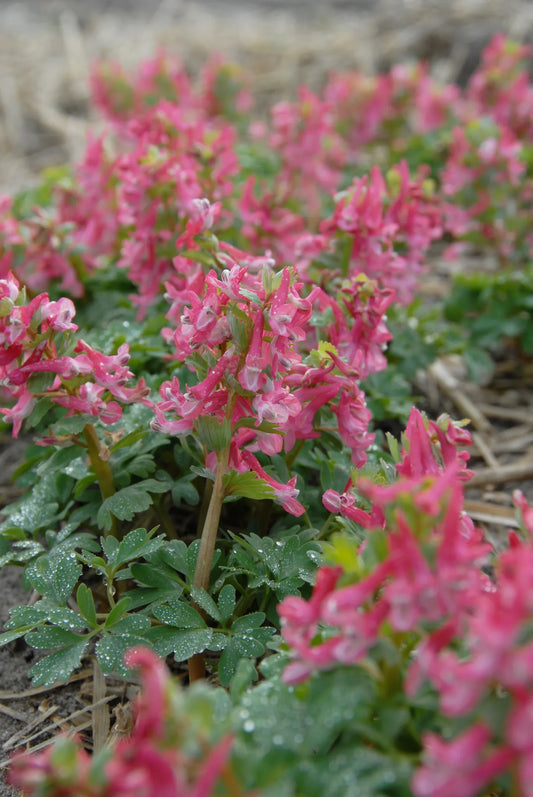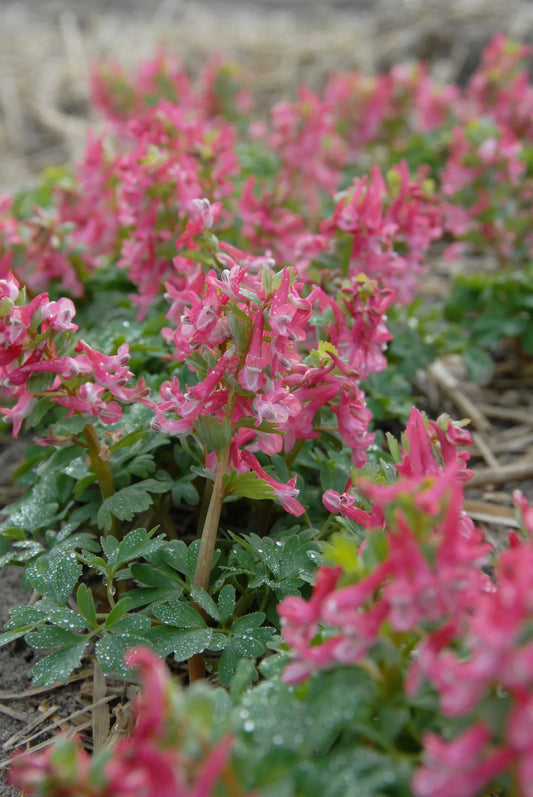-
Livraison dès 10 bulbes France, Suisse et Europe
Modalité livraison -
Grossiste Bulbes de fleurs en ligne
-
Bulbes de Qualité
-
Paiement sécurisé
Virement / chèques / Carte Bancaire /Chorus
Corydalis solida Untreated Flower Bulbs Size 5/+ (3220500)
Corydalis solida Untreated Flower Bulbs Size 5/+ (3220500)
PRICE per bulb € excluding VAT excluding transport
Delivery from mid-September to November - choice at the basket stage
Online shopping available in France and Belgium. For other countries, please request a quotation.
Couldn't load pickup availability
 Limited stock - Buy now and get it delivered when you're ready to plant
Limited stock - Buy now and get it delivered when you're ready to plant
- Delivery from 10 bulbs to France, Switzerland and Europe
Flower Color:
Usage:
Flowering:
View full details
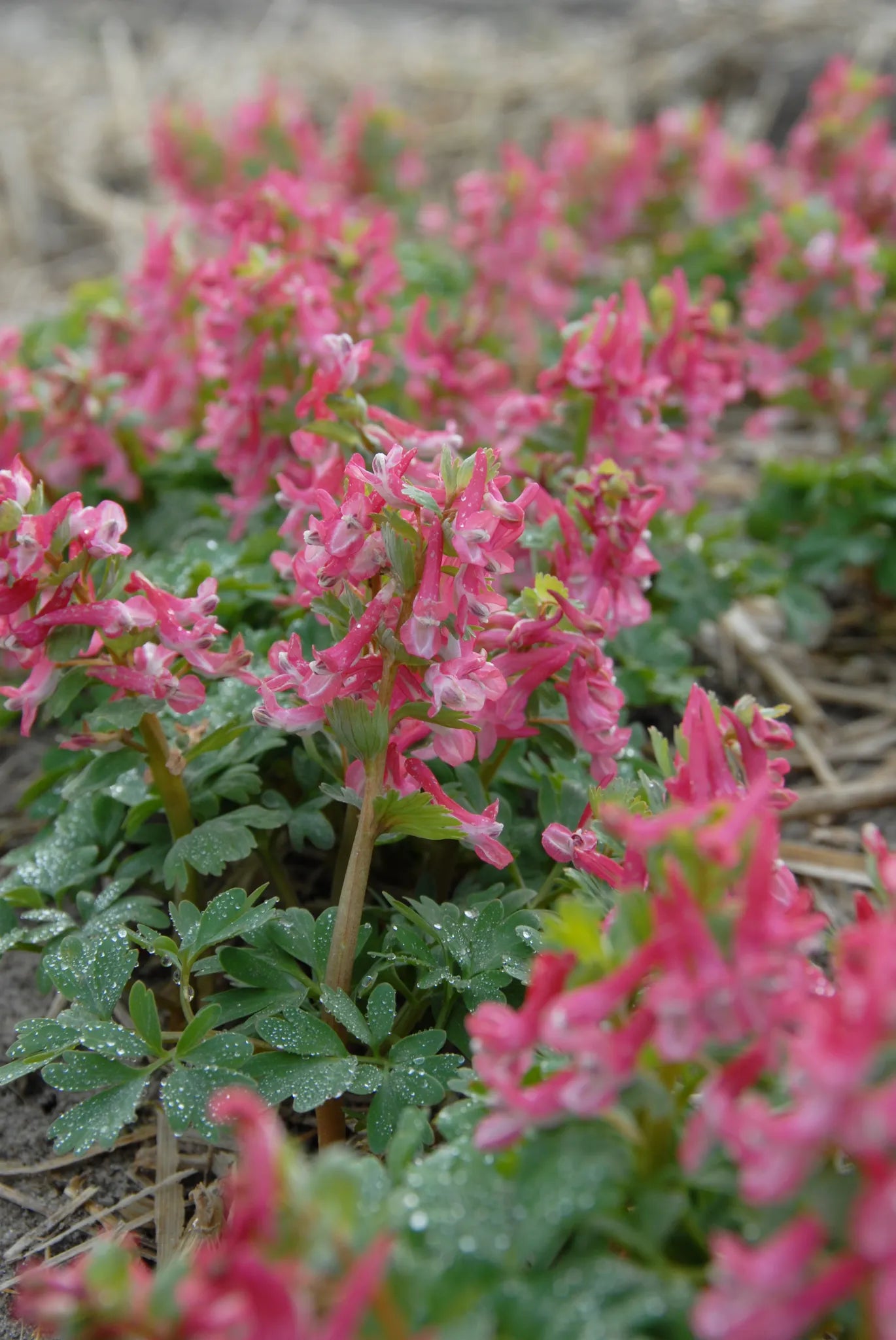
Quality Corydalis Bulbs for Floriculturists and Individuals
Quick read / the essentials on our Corydalis Bulbs
At Floriverse , we are committed to providing professionals with a distinctive floral range adapted to new market expectations. As a specialist wholesale supplier of flower bulbs , we have carefully selected Corydalis bulbs for their ornamental interest, their ecological adaptability and their niche potential as cut flowers. This perennial tuber plant is distinguished by its prolonged flowering, its wide color palette (blue, yellow, mauve, white, red), its highly decorative cut foliage and, for certain varieties, a subtle fragrance. Thanks to these advantages, buying Corydalis bulbs becomes a real lever of differentiation for French floriculturists committed to local and original production.
Floriverse offers a complete range adapted to all technical itineraries: certified organic bulbs, untreated bulbs, and conventional bulbs from specialized nurseries. Whether you are aiming for spring cut flowers, undergrowth plantings, or community flowerbeds, we support you in the optimal selection and establishment of your crops. With a hardiness reaching -20 °C for certain varieties and flowering possible from March, Corydalis offers a concrete response to the challenges of relocation and ecological transition. Buying Corydalis bulbs from Floriverse means choosing professional quality, efficient logistics, and rigorous technical support, from ordering to flowering.
Our expertise as a specialist wholesale supplier of flower bulbs allows us to offer you personalized quotes, competitive sliding scale prices and technical support on request. Our references include cultivars such as Blue Line® , Canary Feathers or George Baker , all recognized for their floridity, their resistance, and their interest in landscaping and floristry. By choosing to buy Corydalis bulbs from Floriverse, you benefit not only from a high value-added horticultural product, but also from a reliable partner at your side to guarantee the success of your professional projects.
Introducing our range of Corydalis flower bulbs
At Floriverse , a specialist in flower bulbs for professionals , we offer a wide range of Corydalis flower bulbs , carefully selected to meet the expectations of French florists. Our offer includes:
- Certified organic bulbs , suitable for organic farming circuits and farms committed to a sustainable approach.
- Bulbs not treated after harvest , ideal for low-residue production, without formal organic commitment.
- Conventional bulbs from specialist nurseries , guaranteeing performance and profitability for intensive or ornamental crops.
This wide range of organic Corydalis flower bulbs is intended for professionals looking for horticultural quality, genetic diversity and reliable supply.
Corydalis cultivation in France: potential and positioning
The cut flower market in France remains largely dependent on imports, with a structural trade deficit of around €300 million in 2022. Despite a recent decline in consumption, demand remains strong, driven by 41% of French households purchasing cut flowers in 2022.
Of the 2,761 ornamental horticultural farms in France, only 400 are dedicated to cut flowers, concentrated mainly in PACA, Pays-de-la-Loire and Île-de-France. The emergence of new profiles in conversion opens up opportunities for the introduction of new species such as Corydalis.
Although currently underrepresented, Corydalis has real commercial potential:
- Extended flowering (spring or until autumn depending on the variety).
- Finely cut foliage, very ornamental.
- Palette of rare colors on the market: blue, yellow, mauve, white, red.
- Soft and pleasant fragrance for certain selections like Blue Line® Couriblue .
It is a niche flower with high added value for producers wishing to stand out in the local and labeled offer (e.g.: Fleurs de France). Its introduction in traditional production areas could boost the offer of original French cut flowers.
Our commitments and services for professionals
Our Corydalis flower bulb offer comes with a value-added service designed entirely for professional florists:
- Personalized technical advice and dedicated support to accompany each cultural itinerary.
- Free quotes within 48 hours and the possibility of booking in advance of the season to secure supplies.
- Careful delivery throughout France within 15 days during peak season.
- Professional quality guaranteed with bulbs produced by specialist nurseries renowned for their expertise.
- Online and wholesale sales with producer prices and decreasing rates according to volume .
- Unbeatable value for money to meet the economic constraints of horticultural operations.
- Responsive sales service : a clear and rapid response, without complications.
With Floriverse, sourcing Corydalis bulbs becomes simple, transparent, and professional. Our ambition: to support every grower in the success of their flower crops, with bulbs delivered directly to your home , at the best price and in the best conditions.
Classification and botanical family
The genus Corydalis , attached to the botanical family Papaveraceae (after having been classified in Fumariaceae according to previous classifications), offers a remarkable diversity for plant professionals, whether floriculturists , nurserymen , producers , landscapers , or those responsible for green spaces within communities or private domains. These perennial bulb or tuber plants have technical and aesthetic characteristics adapted to a wide range of applications in professional cultivation and landscaping in France.
Diversity of species adapted to cultivation in France
The genus Corydalis includes nearly 150 different species. Among these, some are particularly relevant for cultivation in France. The full scientific name includes the genus and species. The accepted family, according to the APG IV classification, is Papaveraceae . For example, Corydalis solida (L.) Clairv. and Corydalis cava (Schw.) both belong to this family.
Geographical origin and natural habitats
The geographical origin varies according to the species. Corydalis solida , also called solid corydalis, is a temperate Eurasian plant, widely present in Europe and extending to temperate Asia and Siberia. In France, it is quite widespread, although its presence is rarer or non-existent in certain regions such as Brittany, the Aquitaine Basin, the Mediterranean South and Corsica. Its natural habitat is in cool, humus-rich undergrowth . It particularly likes ash-oak groves (syntaxon Fraxino excelsioris-Quercion roboris ). It is found from the plain up to about 1,200 m altitude , avoiding dry mountain slopes.
Morphological analysis of the plant
Nature of the bulb and storage specificities
The Corydalis reserve organ is generally a full bulb , more precisely a solid tuber , not to be confused with a tunicate bulb. In Corydalis solida , this tuber is rounded to ovoid in shape, compact and full. Its diameter is typically between 1 and 3 cm at maturity. The outer skin is beige to pale brown in color, while the inner flesh is white to cream. This tuber, unlike other spring bulbs , is very sensitive to drying out, requiring rapid logistics between harvesting, marketing and planting to ensure optimal recovery. However, it allows the plant to withstand intense cold, down to -15 °C thanks to its reserves. Corydalis cava has a hollow, swollen bulb , ovoid to spherical in shape.
Foliage typology and persistence duration
Corydalis foliage is finely cut, giving a delicate appearance, often compared to that of ferns. The leaves are generally bipinnate to quadripinnate . In Corydalis flexuosa , the foliage is described as "chiseled" and can reach 10 to 12 cm in length for horticultural forms, or even up to 15 cm depending on the species. The texture is fine, tender and slightly fleshy, soft to the touch, contributing to a light and airy appearance. The color varies from medium green to bluish green or glaucous . Corydalis flexuosa has "glaucous" foliage, and Corydalis scouleri has "blue-green" foliage. Some varieties may have bronze highlights in spring or in strong light. The foliage persists from March-April to June-July for deciduous species such as C. flexuosa , and can extend into September if conditions remain cool and humid. On more robust species, it can remain from March-April to September-October , or 6 to 7 months . The typical length of the leaf blade is 6 to 12 cm , with 15 to 30 segments or leaflets per leaf for the very divided forms.
Flower form and flowering parameters
Corydalis flowers are tubular , characterized by a distinctive "lip" shape and the presence of a spur at the rear. They are arranged in terminal raceme- like inflorescences (clusters). Flower size varies by species; for example, for some varieties, the upper petal measures about 15 mm , the lower 12-13 mm , and the inner ones 10-11 mm , with a spur of 3-4 mm . Colors cover a wide range: purple for Corydalis cava , pale yellow to white , light yellow for the pale corydalis ( Corydalis flavula ), bright blue for the type species, or intense blue with a white throat for 'Blue Line'® . Some flowers are nodding (nutant) . They may give off a sweet fragrance for some cultivars. Flowering occurs mainly in spring, from April to May , but can begin as early as March for C. cava and C. solida . It can be prolonged by cutting off faded flowers . After flowering, pods containing rounded seeds of about 2 mm are formed.
Vegetative habit and dimensions at maturity
The general habit of Corydalis is mainly upright , forming bushy and round clumps . The structure is light and airy thanks to the flexibility of the stems. The height at maturity varies significantly according to the species:
- Corydalis solida : 10 to 30 cm
- Corydalis flexuosa : 30 cm (according to some sources) up to 60 cm (according to others). Width from 20 to 40 cm . Upright habit with slightly flexible branches.
- Corydalis Canary Feathers : 25 cm high , 30 cm in diameter . Compact shape, ideal for ground cover.
- Corydalis elata : 45 cm high, 20 cm wide. Upright, taller
- Corydalis solida (type/common) : 20-25 cm height, 20 cm diameter
- White corydalis (Corydalis ochroleuca) : often as wide as it is tall
Vegetative cycle and multiplication strategies
Annual periodicity and summer dormancy
Corydalis are perennial plants , capable of living for several years with proper care. Their annual cycle is characterized by active growth in spring , followed by a period of dormancy . The aerial parts may disappear in winter, or in summer in case of heat or drought. Some species, such as Corydalis ochroleuca , may retain reduced foliage in winter . Corydalis flexuosa 'China Blue' is notorious for its summer dormancy .
Propagation by bulbils or directed sowing
Propagation is preferably carried out by the production of bulbils (natural or manual division) or by division of the bulb/tuber . Sowing is possible but slower and more variable.
- Bulbils/Division : Each plant produces 1 to 3 bulbils per year, sometimes more depending on conditions. It is possible to separate 2 to 5 usable bulbils per mature bulb during summer division. A bulbil takes 2 to 3 years to reach full flowering maturity. This method is fast , reliable and guarantees fidelity to type .
- Sowing : Germination rates vary from 20 to 60% and may require cold stratification for 3 to 5 months . Seedlings from seed take 3 to 4 years to flower and fidelity to type is not guaranteed.
Selection of varieties suitable for professional use
Horticultural selection criteria
Several species and cultivars are distinguished for professional cultivation in France:
- Corydalis solida : Height 10-30 cm . Purple flowers, but also available in white and pink . Early flowering (March-May). Finely cut foliage . Solid tuber . Suitable for undergrowth and shaded beds.
- Corydalis lutea : Height 15-20 cm , spread 30 cm . Continuous bright yellow flowers (April-November). Very hardy, bluish foliage , fast growth. Excellent ground cover . For naturalization , borders , fresh rockeries .
- Corydalis 'Blue Line'® : Height ~ 20 cm . Intense blue flowers with white throat . Long flowering (spring-frost). Floral abundance , sweet fragrance , increased hardiness . For flowerbeds , walls , pots .
Other selections of C. solida such as 'George Baker' (brick red) or 'Beth Evans' (bright pink) exist, of similar height (~20 cm) and early flowering. Professional selection criteria include hardiness , vigor , flowering time and adaptation to the soil .
Optimal growing conditions
Soil and drainage requirements
Corydalis prefer a light, humus-rich , fertile soil , reminiscent of "undergrowth earth". They do not tolerate heavy , clayey or overly calcareous soils well. A sandy-loam or humus-loam texture is ideal. The optimal pH is between 6.0 and 7.0 (neutral to slightly acidic), avoiding soils that are too calcareous (pH > 7.5). Excellent drainage is essential; the bulbs fear stagnant moisture , especially in winter. The soil must be fresh in spring but never soggy. For heavy soils, an amendment with coarse sand and compost is recommended.
Light exposure management
Most species thrive in partial shade , receiving 3 to 6 hours of direct light per day, ideally filtered or soft light (morning/evening sun). Light shade (less than 3 hours of direct sun) is tolerated, but full summer sun , especially in hot regions, should be avoided as it accelerates dormancy and drying out . In professional greenhouse cultivation, 40-60% shade may be necessary in full sun.
Water requirements and nutritional intake
Corydalis are not very demanding in water but prefer moist soil . During active growth , water when the first 2-3 cm of soil is dry, moistening the root zone without soaking. An indicative application of 5 to 10 L/m² every 1 to 2 weeks in dry periods may be necessary. Under cover, reduce application (about 80% of the local ETP ). Excess water , especially in winter or dormancy, is fatal for the bulbs.
For fertilization , Corydalis are not very demanding . A contribution of compost ( 100-150 g/m² ) at planting is often sufficient. A light contribution of organo-mineral fertilizer (type 3-2-4 ) at emergence ( 30-50 g/m² ) can be beneficial. Monitor for deficiencies ( yellowing for nitrogen , purple coloring for phosphorus , etc.).
Planting techniques and hardiness
The ideal planting time for bulbs or rhizomes is autumn ( September to November ) or early spring ( February to April ), excluding periods of frost or drought. Plant when the soil temperature is above 5°C . It is technically possible to plant all year round if the soil is not frozen or dry.
The recommended planting depth is 10 to 15 cm for bulbs, with the "eyes" (buds) facing upwards. For rhizomes, bury them 4-6 cm deep. The spacing between bulbs in the ground is 15 to 20 cm . For group plantings, maintain 10 to 30 cm depending on the desired effect.
Corydalis hardiness is good to excellent , generally tolerating negative temperatures down to about -18°C ( USDA Zone 6 , UK 6 ). Some varieties like 'Canary Feathers' are hardy down to -20°C . This cold resistance is sufficient for most French regions.
Effect of vernalization on flowering
A cold period ( vernalization ) is beneficial for inducing and improving flowering. Exposure to temperatures between 5°C and 8°C for 4 to 6 weeks is effective in increasing the percentage and number of flowers . Temperatures above 15.5°C have no effect.
Maintenance practices and phytosanitary management
Watering regulation and post-flowering maintenance
Watering should be appropriate, abundant during dry periods or heat waves , but stopped during summer dormancy . Cool but well-drained soil is key. Removing faded flowers prolongs flowering and improves aesthetics. Also remove dead or damaged stems with clean tools.
Usefulness of mulching according to the seasons
Seasonal mulching is helpful, although not mandatory for hardy varieties. A 5-7 cm layer of dead leaves , BRF or compost in autumn protects against frost, maintains moisture and limits weeds. Remove the mulch in spring for the shoots to emerge. Summer mulching keeps the soil cool.
Disease and pest prevention
Corydalis can be prone to fungal parasites (bulb rot), bacteria or pathogenic algae . Waterborne contamination is possible. For prevention , use healthy bulbs , avoid over-irrigation , and practice crop rotation (avoid replanting Papaveraceae in the same place for 3-4 years). Quickly eliminate infected plants and, if necessary, use suitable fungicide treatments .
Health quality indicators
Bulb health is judged by their uniform color (beige to light brown), firm texture , absence of lesions, and a size between 1.5 and 2.5 cm for common species. Healthy foliage is bright green to bluish , well-expanded and without premature yellowing. Growth must be regular . A germination rate > 85% is a good indicator. Deficiencies in nitrogen , phosphorus , potassium , magnesium or iron are manifested by specific chlorosis or necrosis on the foliage. Wilting despite moist soil indicates a root problem.
Harvest and storage conditions
Bulb harvesting calendar and methods
The bulbs are harvested in late spring/early summer , when the foliage has completely faded ( late May to early June in France). Dig up carefully , leave to dry in the shade , clean and remove any damaged parts . The seeds are harvested just before the capsules open , which ripen quickly after flowering.
Optimized storage of bulbs and seeds
Store bulbs in a dry , dark , well-ventilated place between 10 and 15°C . Use paper bags , nets or trays ; avoid plastic. A dry substrate ( sawdust , vermiculite ) can help. Check regularly for health . Seeds should be sown immediately after harvesting as their viability is short . If storing, keep cool and away from moisture , and sow within a few months .
Landscape enhancement and professional uses
Integration into planting plans
Corydalis are particularly suitable for various landscaping projects and offer advantages for communities and large spaces . With a height of 0.15 to 0.25 m and a width of 0.20 to 0.30 m for C. solida , these plants are ideal for foreground or ground cover . They fit perfectly into undergrowth , creating colorful carpets in spring. Shady rockeries are also suitable for them. Bulbous Corydalis are propagated by seed , giving excellent naturalization capacity. Some species can become invasive under certain conditions. Their deciduous foliage in summer requires planning plant successions .
Benefits in public and community developments
Corydalis are an efficient technical choice for public spaces . Their hardiness and adaptation to temperate climates make them ideal for long-term planting without intensive maintenance . They require little watering or fertilization once established, and naturalize , reducing the need for renewal or plowing . This allows for a significant reduction in maintenance costs . Their early flowering (March-May) provides a visual impact as soon as winter ends . Natural propagation densifies beds , limiting weeds. By flowering early , they provide resources for early pollinators . A density of 50 to 70 bulbs/m² is recommended for a rapid covering effect .
Attractiveness to early pollinators
Corydalis strongly attract pollinators , especially honeybees ( 68.0% of visitors on C. solida , 62.5% on C. cava ) and bumblebee queens ( 32.0% on C. solida , 37.5% on C. cava ). Bees mainly collect pollen ( 82% ), bumblebees nectar ( 68.0% ). Their early flowering is crucial for pollinators emerging in spring. C. cava produces on average 4.6 kg/ha of sugar and 2.1 kg/ha of pollen, C. solida 5.2 kg/ha of sugar and 4.1 kg/ha of pollen.
Complementary plant compositions
For aesthetic associations , Corydalis combines well with Brunnera argentata , Arum lily, and stag's tongue fern ( Asplenium scolopendrium ) for foliage contrasts , or with tulips for spring effects . Yew topiaries create an interesting structure . Culturally, planting under deciduous trees benefits from dappled shade and spring light before bud break. Rock gardens offer excellent drainage.
Aesthetic interest after flowering
After flowering , ornamental interest persists thanks to the finely cut , textured and often tinted foliage ( bright apple green for 'Spinners' with dark red stems, or red hues for C. nobilis after flowering). This foliage forms dense, spreading clumps , maintaining visual appeal in undergrowth , rockeries or borders .
Specificities of cultivation in a controlled environment
Growing in pots and under cover
Growing in pots or under cover is possible. Use a well-drained substrate , rich in organic matter . A coarse sand/potting soil mixture is effective in pots. Plant the bulbs 10-15 cm deep . Keep the substrate moist in spring and dry in summer/autumn. A thick mulch on the substrate is beneficial. Ensure good ventilation under cover. For commercial finishing , allow 5 to 6 weeks in 10-13 cm pots.
Flowering forcing techniques
Forcing for off-season flowering is technically possible but requires careful control of conditions . Corydalis prefer shade or partial shade , to be propagated under cover. Seed germination may require 6 weeks at 22°C . Well-drained and moist soil is required. Dormancy of the species must be respected. The forcing cycle can take 8 to 12 weeks after dormancy. Local trials are recommended to optimize protocols .
Active substances and professional precautions
Bioactive compounds and toxicological issues
Corydalis contains powerful alkaloids such as corydaline (mildly hallucinogenic in low doses, paralyzing in high doses) and bulbocapnine (active on the nervous system ), conferring toxicity . These compounds are used medically .
Logistical constraints linked to marketing
The C. solida tuber presents a major commercial constraint : its sensitivity to drying limits its marketing window to approximately one month after harvest. Sale in pots is preferable or shipping must guarantee very rapid planting after receipt.
To summarize: Our Corydalis Bulbs
Corydalis bulbs offered by Floriverse meet the expectations of professionals looking for species with a strong botanical identity, while offering proven performance in cultivation. Thanks to their early flowering, their diversity of colors, their compact shape and their graphic foliage, Corydalis are suitable for various uses: spring cut flowers, enhancement of shaded beds, naturalization projects or potted plantings. As a specialist wholesale supplier of flower bulbs , we ensure consistent quality, reliable technical monitoring and logistics adapted to professional constraints.
To buy Corydalis bulbs , you benefit from a diverse selection at Floriverse (organic, untreated, conventional), packaging calibrated for floriculture operations, and personalized technical support. Our bulbs are harvested, packaged, and shipped in optimal conditions to prevent drying out, with fast delivery throughout France. Our varieties are selected for their hardiness (down to -20 °C), their adaptation to the temperate French climate, and their compatibility with organic or low-input growing systems. By choosing to buy Corydalis bulbs from Floriverse, you benefit from a rare, reliable perennial range with high decorative potential.
Our status as a specialist wholesale supplier of flower bulbs guarantees you field expertise, sound horticultural advice, and an offer that meets current sector challenges: relocation, biodiversity, short supply chains, and high-value production. We help you integrate Corydalis into your growing itineraries by taking into account local soil and climate conditions, targeted yields, and potential commercial outlets (Fleurs de France label, specialized florists, communities). For any request, our team will respond within 48 hours with a clear, personalized, and competitive solution. Don't wait any longer to buy Corydalis bulbs and diversify your production with a rare, floriferous, and profitable species.
-
Corydalis cava untreated flower bulbs size 1 (3220000) for individuals
Regular price €0,86 EURRegular priceUnit price / per -
Corydalis solida Untreated Flower Bulbs Size 5/+ (3220500) for Individuals
Regular price €0,48 EURRegular priceUnit price / per -
Untreated Corydalis solida Beth Evans flower bulbs size 5/6 (3221010) for individuals
Regular price €0,39 EURRegular priceUnit price / per -
Untreated Flower Bulbs Corydalis solida Beth Evans size 5/6 (3221010)
Regular price €0,19 EURRegular priceUnit price / per -
Corydalis solida Untreated Flower Bulbs Size 5/+ (3220500)
Regular price €0,28 EURRegular priceUnit price / per
Floriverse: Online wholesaler of flower bulbs
-
-
Wholesale Flower Bulbs Online
We work with dozens of producers to offer you the best prices for your flower bulbs.
-
Quality
Our producers are selected for their reliability and the quality of their bulbs.
-
Your bulbs at the best prices
We work every year with your partner producers to offer you the best prices

